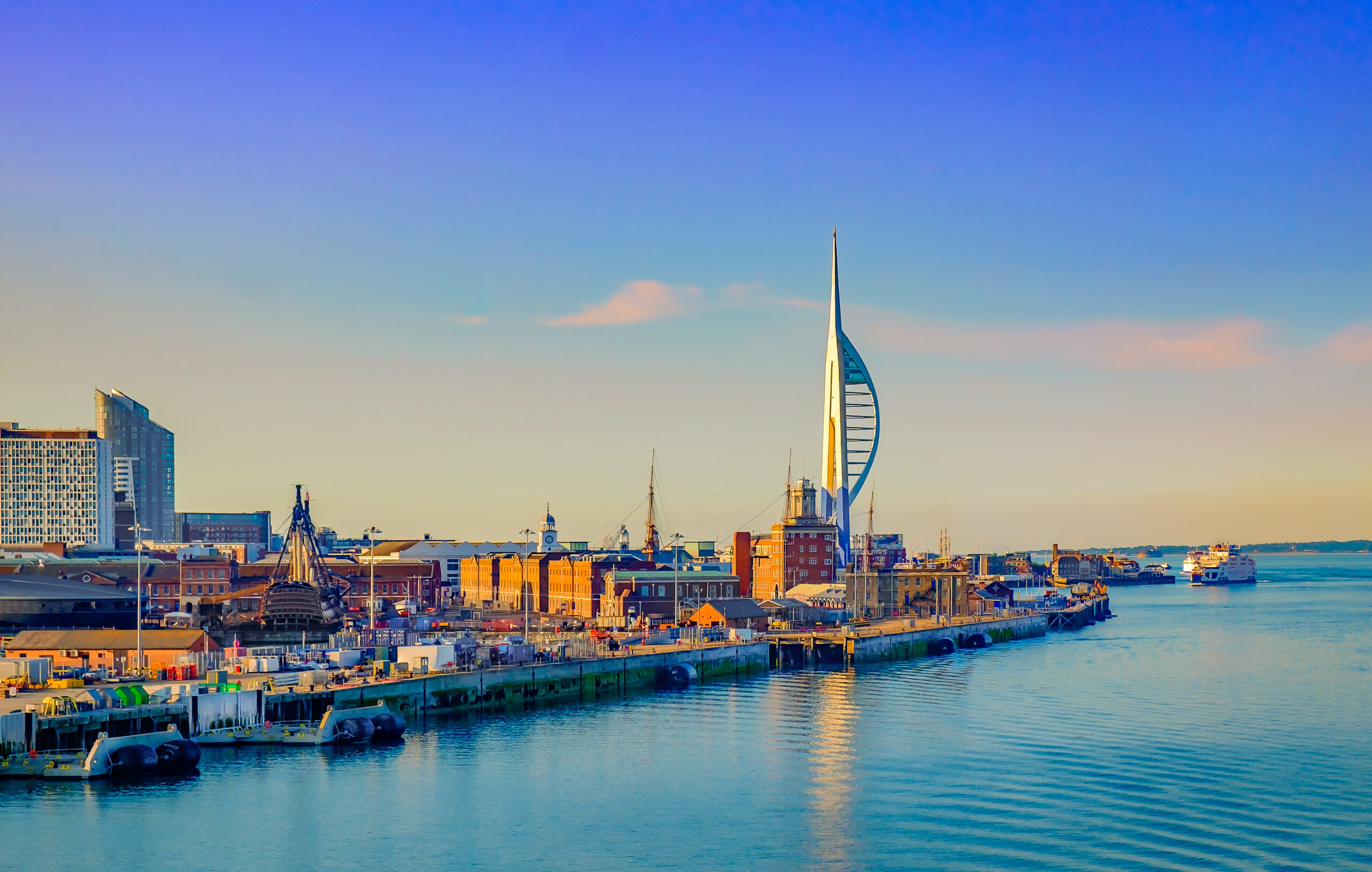Hampshire is located in the south of England, directly on the English Channel coast. It borders Sussex and Surrey to the east, Berkshire to the north and Wiltshire and Dorset to the west. The capital of Hampshire is Winchester. The two large cities of Portsmouth and Southampton belong to Hampshire for ceremonial reasons, but are administratively independent.
Both are important southern port cities and as such have played an important role in the history of the country. Off the coast of Hampshire is the Isle of Wight, which is a county in its own right. The island can be reached by ferry from either Portsmouth or Lymington.
The New Forest National Park is also located in Hampshire. It was once a royal hunting ground and has been a national park since 2005. The administrative center of this area is the small town of Lyndhurst. The South Downs National Park also stretches from Sussex into Hampshire.
The 160 km long South Downs Way, which begins in Eastbourne, ends in Winchester. But many smaller towns also enchant their visitors on their vacation trip and transport them into the history of the country.
Southampton

Southampton is a vibrant waterfront city that combines its rich maritime heritage with modern attractions. Whether you’re strolling through the historic districts or exploring the contemporary parts of the city, Southampton offers a wonderful experience for all visitors.
As a major city and port on the south coast of England, the Port of Southampton is a gateway to a world of adventure. The promenade along the marina invites you to explore the maritime charm of the city. Southampton was once a major trading port and has developed into a brilliant tourist destination, boasting an array of cafés, restaurants, museums and galleries.
Not far from the city, you’ll also find expansive beaches and idyllic national parks, as well as some quintessentially English delights – from fish and chips served unceremoniously straight from the tray to warmly welcoming pubs.
The remains of Southampton’s medieval city walls and ruined towers will take you on a journey through history. These ancient fortifications offer a glimpse into the city’s past and guide inquisitive visitors along the 2-kilometer perimeter, which includes 13 remaining towers and six city gates.
Immerse yourself in Southampton’s maritime history at the Sea City Museum. The interactive museum explores the city’s links to the RMS Titanic and explains how the tragedy affected local people. It also features various maritime exhibitions and the history of Southampton, from Roman traders to the Second World War.
Portsmouth
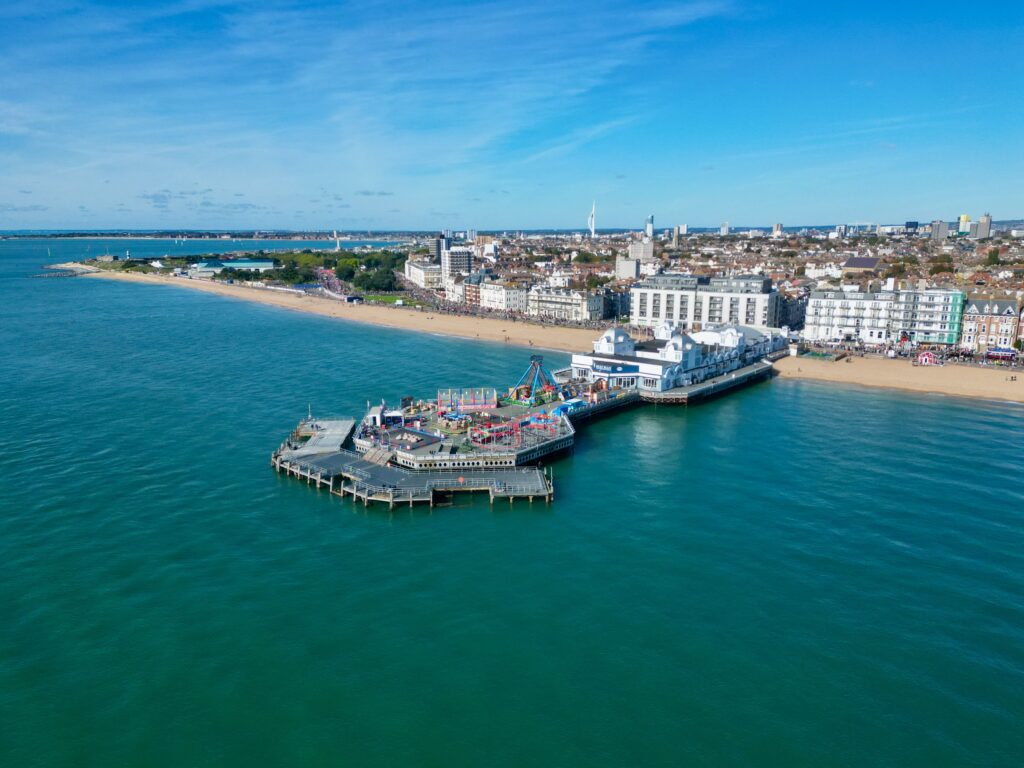
The Royal Navy has used Portsmouth as a naval base since 1194, which led to it being declared a Royal Dockyard in the 15th century. In concrete terms, this means that it became the site of the first dry dock in Europe.
From the more recent past, the so-called D-Day on June 6, 1944 remains particularly memorable. The day on which Allied troops landed on the beaches of Normandy and opened up a second front against the Third Reich in the west. The operation was launched from Portsmouth.
The destruction of Portsmouth during the Second World War necessitated extensive reconstruction of the port from 1955 onwards. The restoration concentrated on this area, as it was then as now the city’s flagship. It is an important ferry port and a must-see for all visitors to Portsmouth. Attached to the base you will find other attractions such as the Royal Navy Museum.
The tallest accessible building outside London is the Spinnaker Tower, which towers over the harbor like a lighthouse and resembles a sail. It is 170 meters high and is Portsmouth’s landmark as a tribute to maritime history.
It combines several viewing platforms, one on top of the other, which offer views of the city, the harbor and the water all year round. The particularly brave can venture onto the Skywalk with its glass floor.
Basingstoke

Basingstoke is a town with a rich history dating back to Roman times. It is mentioned in the Domesday Book of 1086 as a small market town. Its development took off with the age of industrialization, with the construction of the Basingstoke Canal in the 18th century and the arrival of the railroad in the 19th century shaping the townscape. Historic buildings such as the 16th century “The Mote” and St. Michael’s Church still bear witness to Basingstoke’s rich past.
Basingstoke offers a wide range of cultural activities. The Anvil, one of the most renowned concert halls in southern England, attracts visitors with an extensive program of music and theater performances. The Willis Museum and Milestones museums, meanwhile, provide an insight into the local history and heritage of the region.
Basingstoke, a town that skillfully balances idyllic greenery and urban structure, is a prime example of the successful fusion of nature and architecture. Nestled in the picturesque Hampshire countryside, it offers visitors breathtaking green spaces such as the War Memorial Park and Eastrop Park, with their expansive meadows and tranquil rivers.
In terms of architecture, Basingstoke reflects the delightful symbiosis of historical heritage and contemporary architecture. Medieval churches stand in harmonious contrast to modern complexes such as The Malls shopping center or the Willis Museum and Sainsbury Gallery. This combination makes the architectural landscape of Basingstoke extremely diverse and dynamic.
Gosport
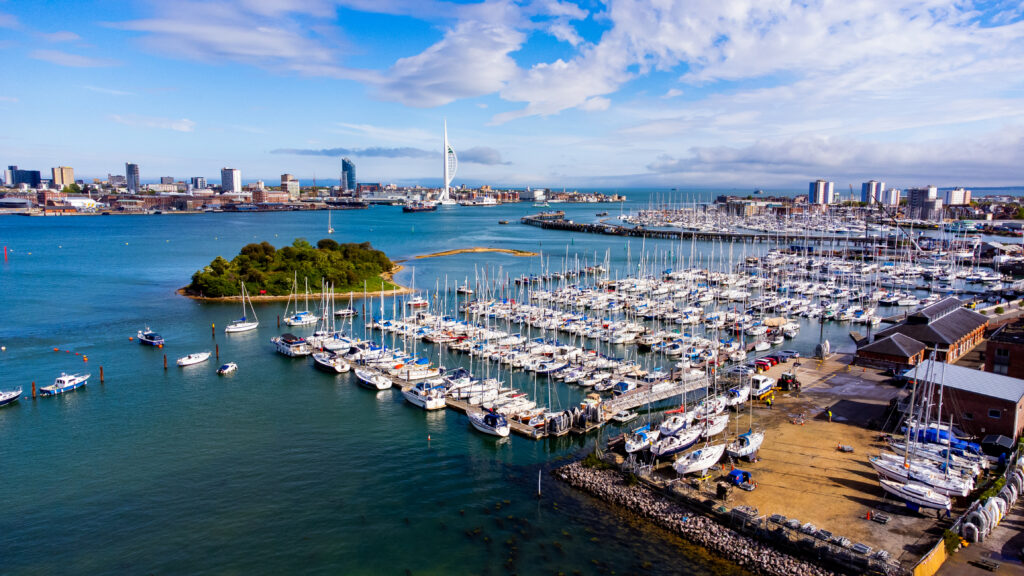
Located on England’s south coast, Gosport offers an irresistible mix of fascinating places to visit and things to do for all ages. With its 24 miles of waterfront, safe panoramic beaches, impressive naval heritage, scenic countryside walks and historic trails there is much to keep visitors entertained.
Find out what lurks beneath the waves at the Royal Navy Submarine Museum. Take a tour of Britain’s only surviving WW2 era ocean-going submarine to discover what it was like to live and work on a submarine.
Learn about the weapons used by the Royal Navy at Explosion! – Museum of Naval Firepower – an award winning museum of naval warfare set within the 18th century buildings of the Royal Navy’s former armaments depot at Priddy’s Hard.
Follow the 2 mile Millennium Waterfront Trail that links these two sites to enjoy spectacular views across Portsmouth Harbour taking in the Falkland Gardens, the ‘Timespace’ sundial.
The Diving Museum showcases the best range of military, commercial and recreational diving equipment in Europe (perhaps the World!). Whilst just along the coast is The Hovercraft Museum in Lee-on-the-Solent and home to the only one in the world. It’s diverse and extensive collection consists of over 50 hovercraft, ranging in size from single-seat fun craft to the giant SRN4 that used to operate across the English Channel.
Andover
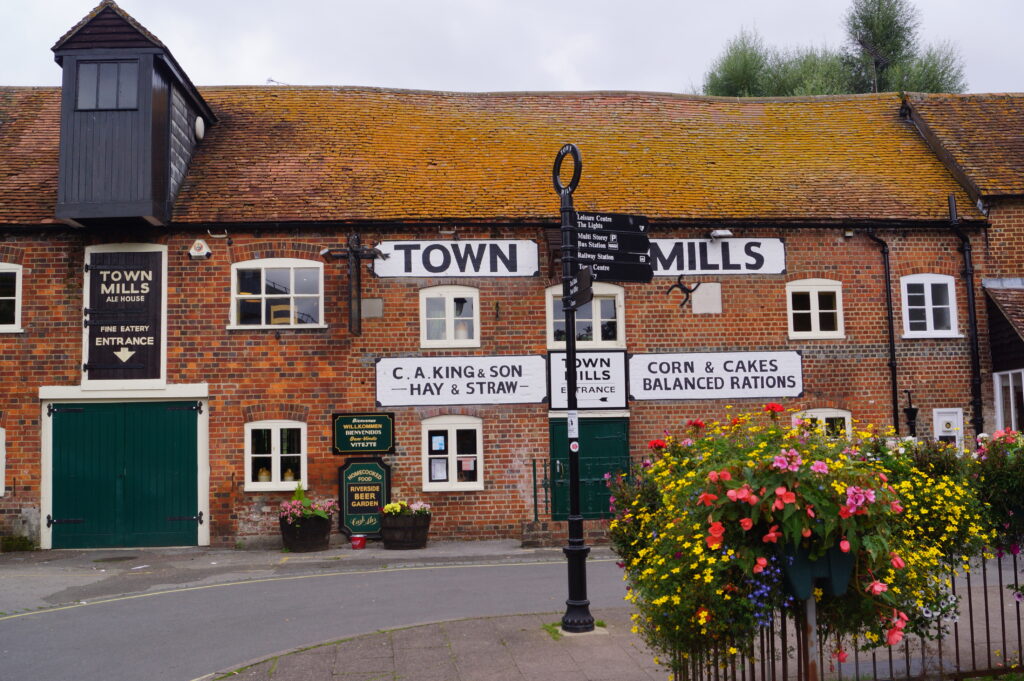
There are plenty of things to do in Andover, an attractive market town in the north of the beautiful Test Valley in Hampshire and has a rich heritage dating back to Saxon times.
During the 18th century the town was an important stop-over route for stagecoaches between London, Salisbury and Exeter yet the nearby Iron Age settlement of Danebury Hill Fort and the Roman remains of the Fullerton Mosaic provide insights into Andover’s more ancient past.
The Andover Museum and Museum of the Iron Age explore this fascinating history in detail while the mosaics of the Andover Time Ring and the colourful Test Valley Tapestry pay modern tribute to Andover’s heritage.
The Museum of Army Flying at Middle Wallop outlines the important role Andover played in two World Wars and the town’s RAF links while there’s more history to explore at nearby Whitchurch Silk Mill and Highclere Castle
For walkers and nature lovers, don’t miss the lovely Test Way walking trail or the Hawk Conservancy Trust and its 150 different birds of prey.
For arts and entertainment in Andover there’s a lively programme of music, dance, theatre and children’s events at The Lights or the exhibitions and activities at the nearby Fairground Craft and Design Centre.
Fareham

The market town of Fareham lies halfway between the larger cities of Southampton and Portsmouth. It combines a High Street of characterful old buildings and a modern pedestrianised central shopping area.
Fareham boasts around 300 shops, plentiful cafes, restaurants and pubs, a wide range of business services and a lively entertainment scene. A compact, easy access pedestrianised town with undercover centre and surrounding speciality shops, Fareham town centre retains its traditional market town and historic architectural appeal in a modern shopping environment.
Fareham has just been awarded World Craft City status in 2021 by the World Crafts Council, becoming the first town in England to be awarded this. The town is now recognised internationally for its unusual and exceptional collection of institutions, makers, and providers of crafts, and becomes part of a global network of creative craft destinations.
Probably the best traditional open-air market in the region, up to 50 stalls can be found in West Street precinct every Monday throughout the year from 9am to 3pm, including all public holidays.
Fareham has been hosting its own independent Farmers Markets since 1998. At these well-established and popular markets you’ll find up to 40 local farmers selling their freshly grown and prepared produce on the first Saturday of the month throughout the year from 9am to 2pm.
Portchester
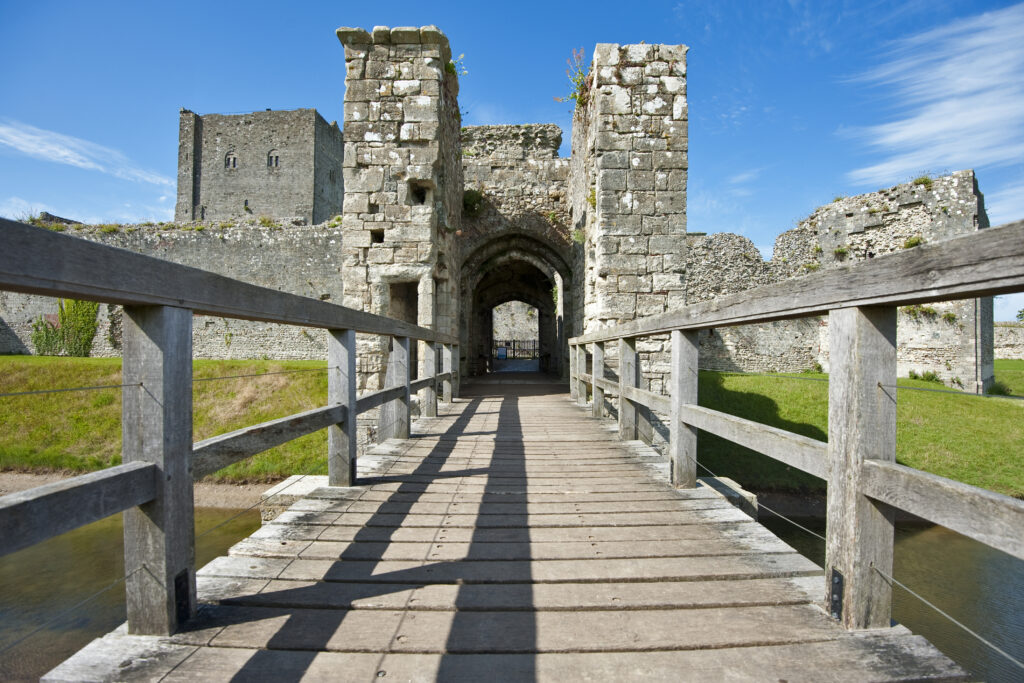
Portchester was in the front line in the Hundred Years War, was transformed into a palace by Richard II and was later used as a prison.
Once a small village, Portchester is now a busy part of the expanding conurbation between Portsmouth and Southampton on the A27 main route.
Anyone who has seen Portchester Castle in Hampshire cannot fail to be impressed.
Henry VIII and Anne Boleyn once holidayed at Portchester but the castle’s origins go back to Roman times.
Portchester is one of the best preserved of the Roman ‘Saxon Shore’ forts and was built in the 3rd century. Covering ten acres, it is the only Roman stronghold in northern Europe whose walls still stand mainly to their original height and with many of its original towers.
The Portchester Castle museum tells the story of this eventful history and from the towers there are spectacular views over the Solent.
The great guns of the Royal Armouries Museum at Fort Nelson look out over Portchester and the Solent from their commanding position on Portsdown Hill and nearby you’ll also find the military attractions of Portsmouth Historic Dockyard and Southsea Castle.
Not far away there’s the tranquillity of Titchfield Haven nature reserve.
Romsey
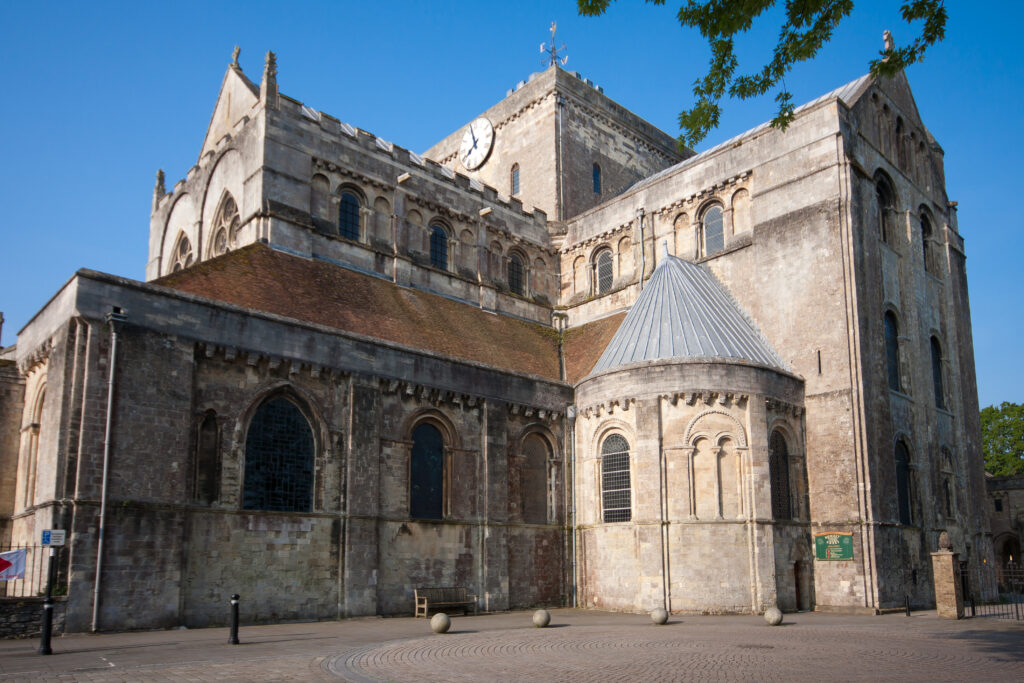
The ancient and prosperous market town of Romsey sits on the banks of the River Test, one of the finest trout and salmon rivers in Europe.
Medieval streets cluster around the magnificent Norman Abbey which dominates the town and plays host to an extensive musical programme each year. The Abbey is the largest parish church in Hampshire and can trace its origins back to 907AD.
The medieval King John’s House, Tudor Cottage and former Victorian Gun shop together make a new heritage centre. As well as some fascinating displays there are a series of period gardens which lead down to a bubbling mill stream.
Just outside the town and set in extensive parklands is the eighteenth-century mansion of Broadlands, the former home of Lord Palmerston and also The Late Lord Louis Mountbatten. Broadlands is open to the public during July and August and hosts a range of craft shows, concerts and events throughout the year.
Mottisfont Abbey, five miles north-west of Romsey, is well known for its walled kitchen garden and a national collection of old-fashioned and species roses.
Another unique attraction is Romsey Signal Box, a fully restored railway signal box open to the public several times each month. Visitors can pull the levers and operate the signals.
Lymington
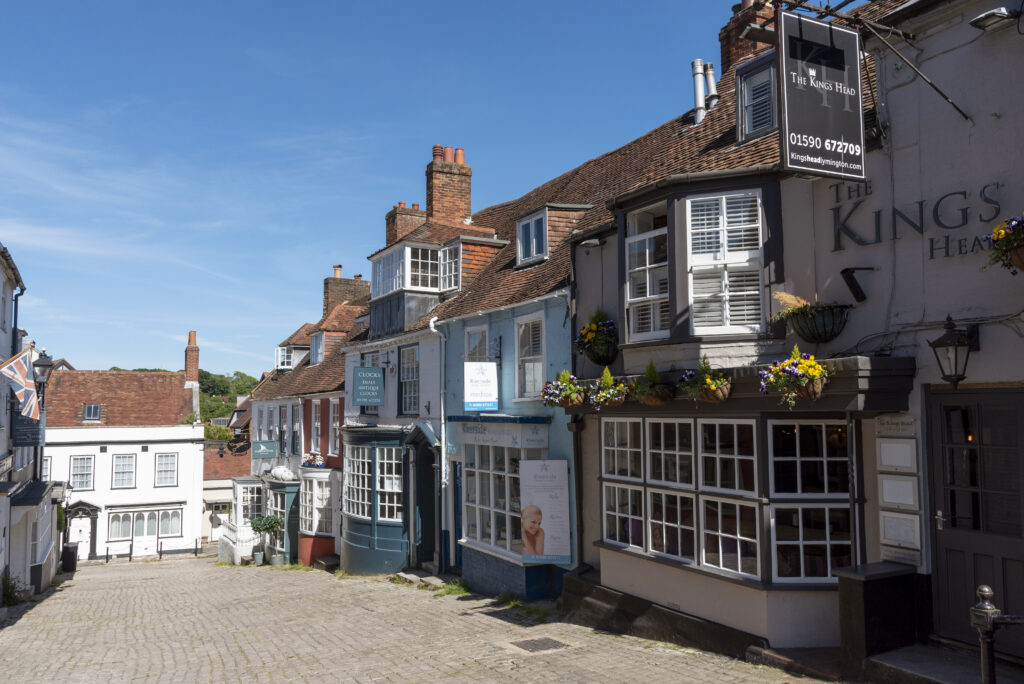
The Georgian market town of Lymington is set on the coast in the beautiful New Forest National Park, between Southampton and Bournemouth. Famous for its sailing history, there are two large marinas filled with fishing boats and yachts, as well as two sailing clubs. The town’s narrow streets are lined with pretty period cottages and houses, as well as plenty of local pubs and restaurants.
Lymington High Street has several independent shops and designer boutiques, as well as a local market held each Saturday which dates back to the 13th century. At the bottom of the High Street, a cobbled road leads down to the Old Town Quay, which is still used by a number of commercial fishing boats.
There is often a chance to buy fresh fish on the waterfront. From here you can take a stroll along the waters edge and soak up the atmosphere of this renowned sailing resort.
Lymington is surrounded by the beautiful countryside of the New Forest, where opportunities for outdoor activities are abundant. The Solent Way footpath provides a great coastal walk with fantastic views of the Needles and the Isle of Wight.
Located to the west of the town is Hurst Castle located on a shingle spit which stretches out into the Solent. This area is a significant coastal nature reserve, recognised as a Site of Special Scientific Interest.
Lymington is home to 19th century open sea water baths, the oldest of its kind in the UK. These baths are popular with all ages throughout the summer months, and are an important part of the town’s history.
Exbury Gardens
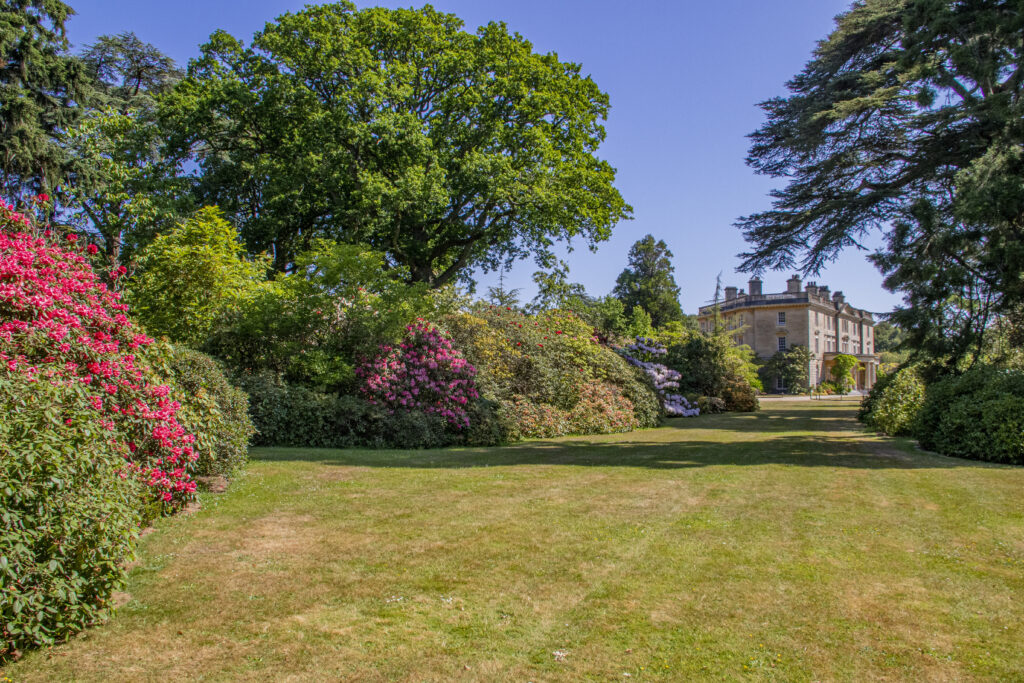
More than 100 years in the making, Exbury Gardens & Steam Railway is a spectacular collection of landscaped woodland, herbaceous, contemporary and formal gardens, in a unique riverside location. Exbury also boasts a narrow-gauge steam railway that travels through the gardens, plus a play area, fantastic restaurant and much more!
Exbury is renowned for spring colour, set apart from other gardens by their world-famous collection of rhododendrons and azaleas. These stunning shrubs are at their height in April and May, lining the paths with elegant flowers. Spring also sees a spectacular display of camellias and magnolias, as well as hundreds of thousands of spring bulbs in Daffodil Meadow and the River of Gold.
Exbury’s 200 acres transform into a shady sanctuary of tranquillity during summertime, with the Iris, Herbaceous, Sundial and Centenary Gardens coming into full bloom at this time of year.
During the colder months, expert planting showcases the vibrant red and orange of their acer and nyssa trees, of which we have a National Plant Collection.
Exbury’s narrow-gauge railway departs from a replica Victorian station ‘Exbury Central’ and travels through a tunnel, over a bridge, round the new Dragonfly Pond and through the Summer Lane Garden, which is only accessible by train.
Breamore House
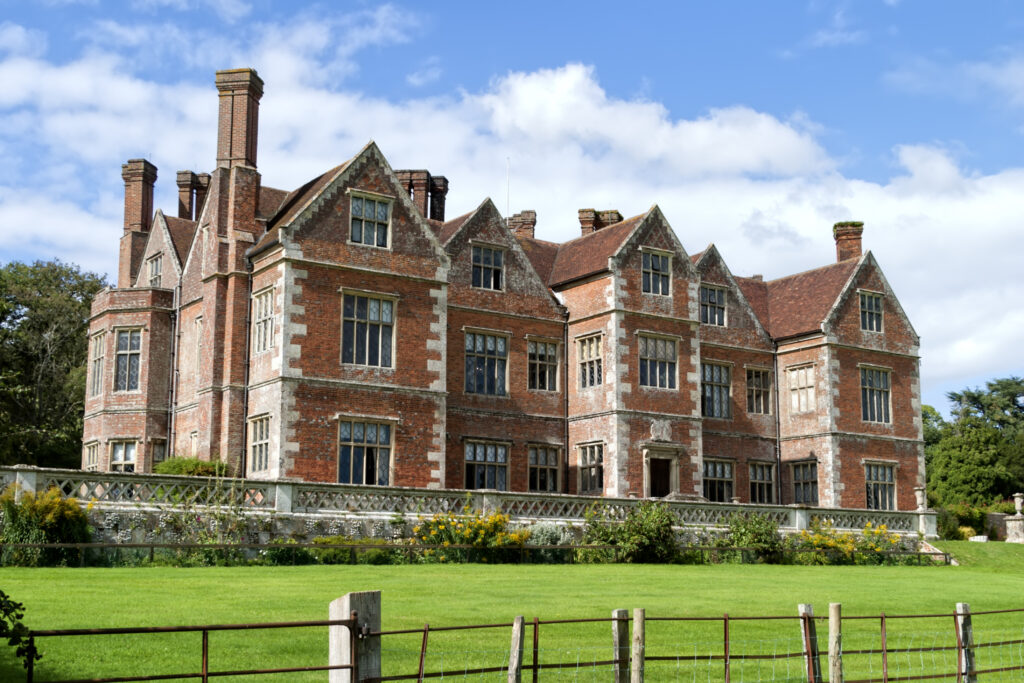
Breamore House is an Elizabethan Manor set above the picturesque village of Breamore, overlooking the Avon Valley on the edge of the New Forest.
The Manor House was completed in 1583 and remains the family home of the Hulses. There is a fine collection of works of art, including paintings of the 17th and 19th Century Dutch School, family portraits, a unique set of 14 Mexican ethnological paintings, fine examples of period furniture crafted from Oak, Walnut and mahogany, tapestries, a very rare James 1 carpet and many other interesting items of historical interest.
Breamore is largely unspoilt 17th century village with many old thatched cottages, and life in a typical village like Breamore can be relived in the Breamore Countryside Museum which provides a fasinating insight into the days when a village was self-sufficient. The museum boasts one of the finest collections of steam powered farm machinery, tractors, barn machinery and historical tools.
There is a Saxon Church which was built around 980 AD and it is one of the most important and interesting Anglo Saxon Monuments in Hampshire.
There is a well stocked Gift Shop, and a Tea Barn which serves light lunches, cream teas and homemade cakes.
Whitchurch
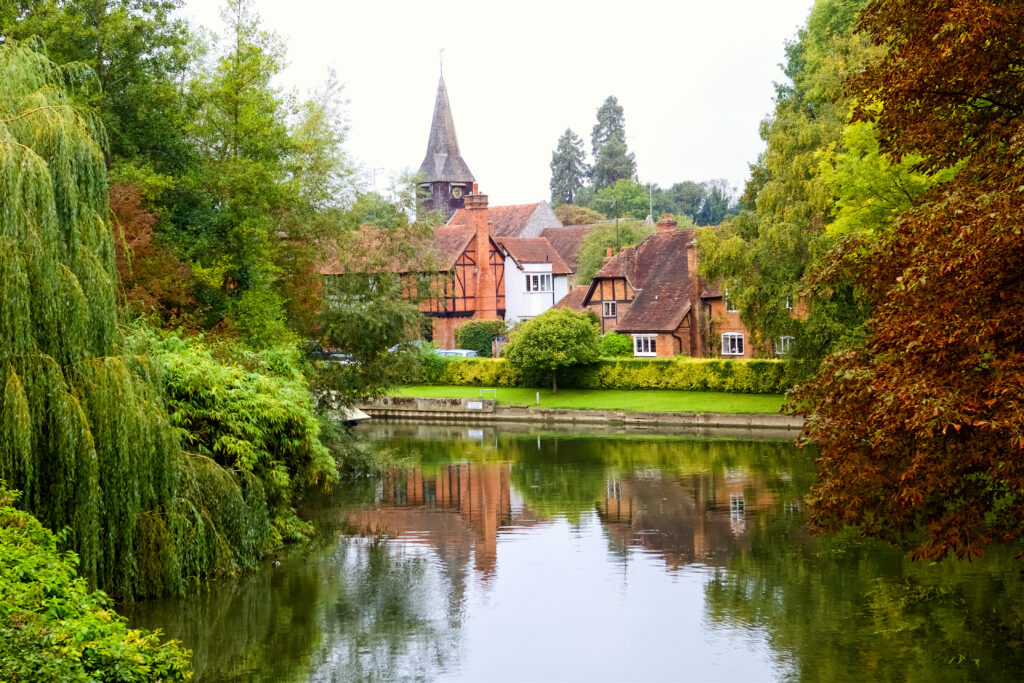
Situated on the River Test and surrounded by picturesque rolling countryside, Whitchurch is Hampshire’s smallest town. Early settlements here date from around 400BC, and there is also evidence of a Roman presence with archaeological excavations unearthing ancient tools and pottery.
Whitchurch has had a church since the 9th century and it is thought that the name may originate from the Old English Witcerce, thought to mean White Church with connections to a chalk construction or to white-washing. The present All Hallows building is grade II* Listed and although the exterior is mostly Victorian, there are remains from the 12th, 15th and 17th centuries.
Much of this charming town is a conservation area and contains many listed and notable buildings. The River Test has had a significant role in the town’s history, and led to some of its earliest industries with five mills being built in the area for grain, wool and paper production. The Portal family took over the lease at Bere Mill in the early 18th century and in 1724 began producing paper for the Bank of England.
Near the centre of the town is Britain’s only working Silk Mill, still operating in its original building. The building dates from 1815 and started producing silk soon afterwards; it is now home to a popular visitor attraction.
There is an attractive waymarked walk known as The Mill Trail along the River Test which passes five historic mills, including the Silk Mill. River crossings allow short cuts to create walks of 2, 3.5 or 4.5 miles.
South Downs National Park

Escape to the South Downs and become revitalised in this peaceful and relaxing part of Hampshire.
Confirmed as a National Park in 2009, the stunning landscape of the South Downs stretches from Winchester and Petersfield in Hampshire to Eastbourne in East Sussex.
The western tip of the South Downs can be found in the heart of Winchester at the magnificent 11th century cathedral. Just one mile from the city centre the South Downs comes into its own with the beautiful countryside of St Catherine’s Hill.
The market towns of Petersfield and Alton are also ideal starting points to explore the South Downs, in the East of Hampshire, as they are full of interest and are dotted with comfortable hotels, B&B’s and self catering cottages.
Skirting alongside the lovely Meon Valley, the Hampshire South Downs also include the pretty village of Selborne and Queen Elizabeth Country Park.
Queen Elizabeth Country Park near Petersfield is home to the highest point of the national park, Butser Hill. At 270 metres high there are stunning views of the surrounding hills, valleys and farmland. With designated picnic and barbeque areas, walks, café and gift shop, it is a great way to spend the day.
A unique feature of this landscape is the hanging woods or hangers. You can walk the Hangers Way, a 21 mile path from Alton to Queen Elizabeth Country Park through Selborne, Steep and Petersfield.
New Forest

Escape to a world a million miles from your everyday life where ponies, cattle, donkeys and deer roam free… and all just 90 minutes by train from London. Experience the peace and fall in love with the forest’s idyllic glades, ancient woodland, open moors, heathland and cliff top walks.
The New Forest National Park has been a cherished destination for generations – a place where time slows, nature thrives, and every visit brings something new to discover. With its ancient woodland, open heathland, and free-roaming ponies, this is a landscape shaped by people and place, past and present. Whether you’re visiting for the first time or returning to a favourite spot, the New Forest is ready to welcome you.
Each season brings a fresh perspective – vibrant flowers in spring, sun-dappled glades in summer, golden canopies in autumn, and frost-kissed trails in winter. Step into the great outdoors, breathe in the crisp forest air, and explore at your own pace. Wander along woodland paths, cycle scenic trails, or visit local attractions and try forest activities.
Venture beyond the trees to uncover charming towns and villages, where cobbled streets lead to independent shops, cosy cafés, and traditional pubs. Follow the coastline for fresh sea air and panoramic views, or visit heritage sites that tell the story of this remarkable landscape.
Chawton

Home of Jane Austen for the last eight years of her life, Chawton is a delightful village near Alton in Hampshire. You can visit Jane Austen’s House, where she wrote or revised all her novels, and see the Chawton House Library where Jane’s brother, Edward Knight lived.
At Chawton, which is today naturally regarded as Jane’s literary home, Jane revised both Sense & Sensibility which was published in 1811 (and made Jane £140), and Pride & Prejudice, which was published in 1813. This was an instant success. Mansfield Park was published in 1814 and Emma in 1815. Persuasion was completed in 1816 but was not published until 1818, after Jane’s death in 1817. Northanger Abbey was also published in 1818.
Jane and Cassandra normally went for a walk every day and used to go shopping in Alton, where their brother Henry, who was a London banker, had a branch bank. This was at 10 High Street, where the family post was delivered and collected.
There is a self-guided circular walk through the countryside that Jane loved, and a walking trail to nearby Alton.
A short walk from Jane’s home is St Nicholas’s Church where Jane’s mother and her sister are buried. The present church was rebuilt in 1872 following a fire which destroyed the church that Jane would have known.
Highclere Castle
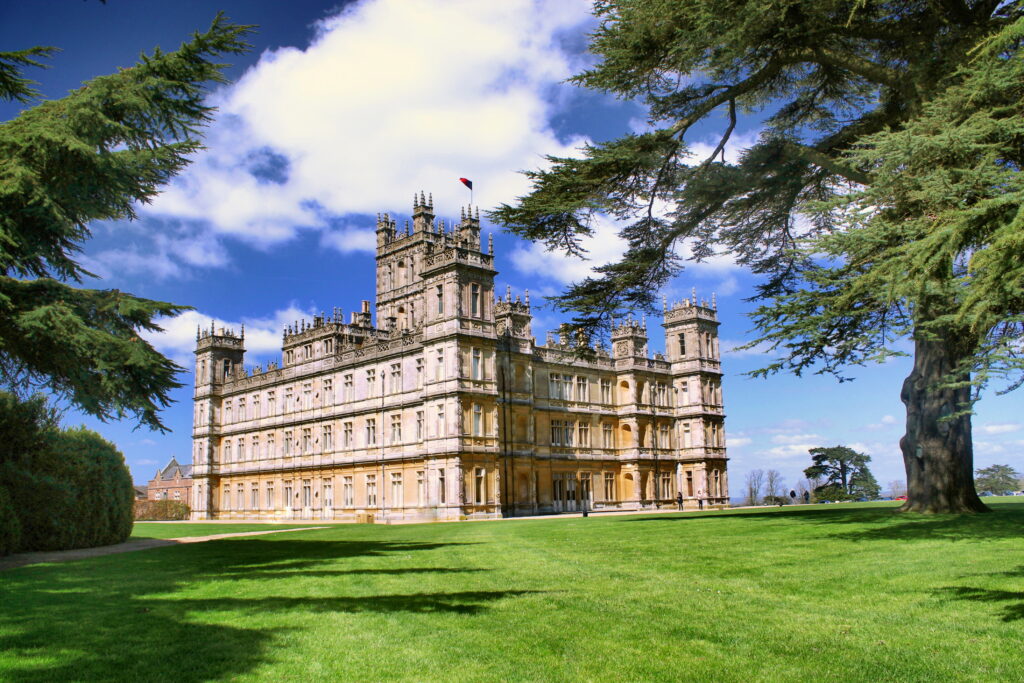
Highclere Castle is a neo-Renaissance manor house in Hampshire, southwest of London. It was built between 1839 and 1842 by the same architect who designed the Houses of Parliament.
The castle gained worldwide fame through the successful British series “Downton Abbey”. On a tour of the interior of the house, it feels as if you have been immersed directly in the series. However, you should not forget during your visit that Highclere is not a film set, but still a privately inhabited family home.
Between the rich treasures of the past, which of course can be seen in the TV series, there are also photographs and references to the current residents: Lord and Lady Carnavon with their family members.
The Egyptian exhibition in the basement of the castle is also particularly worth seeing. After all, it was the 5th Earl of Carnavon, an ancestor of the current owner of the castle, who, together with Howard Carter, discovered the burial chamber of the famous pharaoh Tutankhamun over 100 years ago.
The extensive gardens and woodland surrounding the manor house with the “White Border” of white roses and clematis blossoms are perfect for a stroll. Hot and cold drinks and meals are served in the tea rooms and, for an extra charge, a traditional English afternoon tea with a selection of scones, cakes and sandwiches can be enjoyed in the coach house at Highclere.
Beaulieu
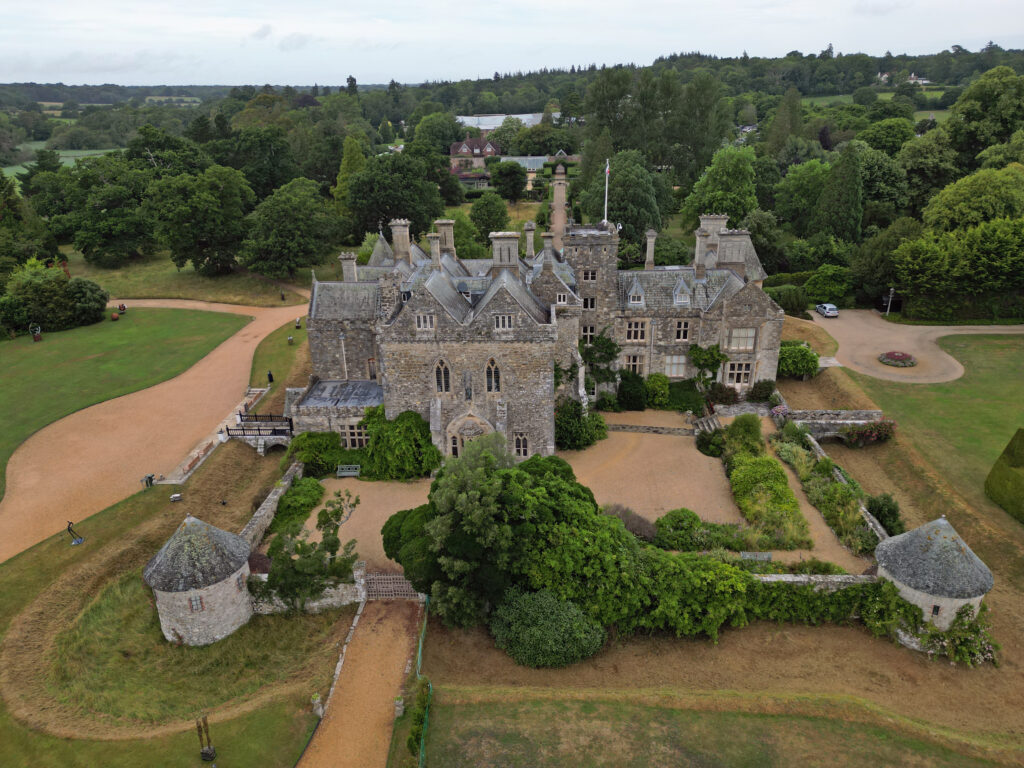
Beaulieu Palace House is located in the town of the same name in the county of Hampshire. Its origins date back to the 13th century, and since the Tudor period, the estate, which is an outstanding example of Gothic architecture, has been continuously owned by the Baron Montague of Beaulieu. Although the current baron lives here with his family, parts of the house and garden are open to the public.
The village of the same name is home to the National Motor Museum. Founded in 1952, it houses many historic motor vehicles. Among them are four land speed record holders: Sir Malcom Campbell’s 1920 Sunbeam, Donald Campbell’s 1961 Bluebird-Proteus CN7, the 1929 Irving-Napier “Golden Arrow” and the 1927 Sunbeam, which was the first to reach a speed of 200 mph (322 km/h).
In addition, you will find the “World of Top Gear” here. See all the vehicles that have ever been modified, battered, and completely destroyed by the Top Gear team. In the Top Gear Simulator, you can experience the thrill of racing in a Caterham and a Bugatti Veyron in an almost lifelike way. A real treat for all fans of the popular BBC car magazine with a difference.
But Beaulieu also has plenty to offer the youngest members of the family, making a visit a real family experience.
Winchester

Winchester is one of the most beautiful medieval cities in England. With a population of around 40,000, the city has remained pleasantly small and yet has experienced great things as the former capital of the kings of Wessex. Winchester is also home to what is probably the most famous table in the country: the round table of the legendary King Arthur.
A Roman settlement once stood where Winchester is today. As early as the 7th century, a cathedral was built on this site, the foundations of which were only discovered in the 20th century under what is now Winchester Cathedral. This makes it one of the oldest cathedrals in the country.
The city really took off when it was chosen as the capital of the Kingdom of Wessex after 839. A statue of the mighty King Alfred the Great can still be found in the city today. It was not until the Normans under William the Conqueror chose London as their capital that the importance of Winchester declined.
But the period after the landmark year 1066 also left many traces. The Great Hall, which was built between 1222 and 1235, is still preserved today. It was part of the former royal residence of Henry III and houses the aforementioned round table of King Arthur and the knights of his Round Table.
The High Street enchants with numerous beautiful historic buildings and half-timbered houses.
Past the cathedral, Cathedral Close leads to other small half-timbered houses, stores and cafés. Winchester is also famous for its college, Winchester College, which was founded in 1382. College Street is also home to Jane Austen’s house, which is now privately owned. The writer was one of the city’s most famous citizens and is buried in Winchester Cathedral.

